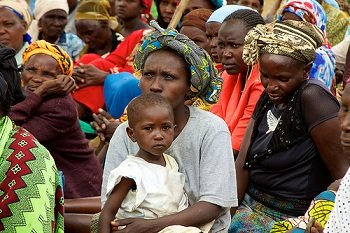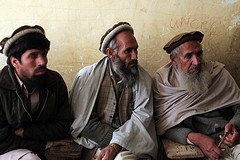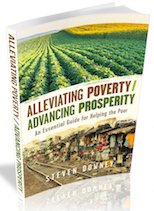A Collective Business System, Commonly Referred to as Community-Based Organizations (CBO’s) or Self Help Groups (SHG), Work Together for the Common Good of the Community and the Benefit of its Members
A collective business system, made up of the people who will be benefitting from any community development program is a vital part of the success and sustainability of that program and its improvements.
The development of good water and sanitation systems involves many factors, and he technical, environmental, economic and cultural aspects of such projects must be well coordinated if the projects are to succeed.
Note: The content on this page has been adapted from publications of USAID entitled “Water for the World”.
Such a balance depends on the interest and participation of the people who will be using the water or sanitation facilities.
An organized collective business system goes by many names depending on the country they are in, the culture they are from, or the NGO’s (or ”Action Agencies”) that help form them.
A collective business system referred to as a Community-Based Organization (CBO) or Self Help Group (SHG) is rooted in or based in a specific community, and geared toward serving that community's needs.

They serve as the voice and the leaders of that community; and are often, but not always formed for a specific purpose or project.
No project or improvement, however well designed and constructed, will benefit its users if it will not last, cannot be paid for, is improperly operated and maintained, or is socially unacceptable and so is not used.
This is where the collective business system becomes so important.
A full exchange of information between the collective business system (CBO) and the action agency during all project phases is very important for successful water and sanitation system development.
This web page reviews the roles and responsibilities of the action agency and the collective business system in preparing to select solutions to local water supply and sanitation problems.
Though presented here within the context of water and sanitation projects, collective business systems like CBO’s and SHG’s pursue many goals for the benefit of the community and serve a vital function in governance and coordination of many different kinds of projects.
Starting a Project
The initial contact between an organization like an NGO, a governmental agency or a charity organization (collectively referred to here as “action agencies”) and the community may be made by either group.
The contact may be a request from the community to the action agency for assistance, based on a local concern for better health, a desire for greater convenience, or an awareness and desire to investigate alternatives to the current systems.
Alternatively, the initial contact may be an invitation from the action agency to the community to work together to improve the a community water and sanitation system as part of a regional or national campaign.
If the community does not have a water and sanitation committee, a CBO or a SHG, the project planner should help form one to represent the village and to work directly with the action agency.
The action agency's project planner and project designer should act as a liaison between the CBO and the agency. Initial discussions between the CBO and the project planners should clarify the priorities of each group.
In the early meetings there should be an attempt to:
1. Specifically identify the water and sanitation problems. Is the current water supply reliable, accessible, of good quality, and of sufficient quantity? Are sanitation conditions present that are likely to cause health problems?
2. Identify the community’s priorities and goals for water and sanitation improvement and the community’s willingness and capability to participate in the project.
3. Identify the action agency’s priorities and goals for water improvement and its willingness and capability to participate.
4. Compare the current water supply with the community’s water needs, including future needs. Relate this information to water use patterns for drinking, bathing, laundry, agriculture, and livestock.
5. Consider current excreta disposal practices.
6. Organize a local feasibility study to identify technical and economic resources specifically for water and sanitation projects.
The Village Water and Sanitation Committee
The community committee (CBO) represents the village and works directly with the project planner and project designer.
Often an already existing local organization exists, such as a rural or village council that can best act as the village water and sanitation committee.
If no appropriate local organization exists, the project planner should assist the community in organizing a locally selected committee to oversee the community's contributions to the project.
The project planner should gather the support of community leaders in organizing a committee that will operate according to the communities own customs.
Ideally, members of the committee should come from all the groups in the village so that the committee is representative of the entire village's needs.
Committee members should be interested in community development, health, and water and sanitation improvements.
They should be well respected by the community, and should have special knowledge, experience, or resources to offer the committee.
Committee members should be able to work with community leaders, health workers, teachers, extension agents, those familiar with local economic conditions,and the various ethnic and age groups in the community.
It is very important that members or the committee be both men and women, so that information on improved hygiene practices related to sanitation and water supply can be effectively communicated through traditional cultural channels.
Women usually teach other family members these practices, so they play an especially important role in water and sanitation education and practice.

t is important also to not exclude men from the committee. Much “to do” has been made, in recent years, of the formation of women’s groups, and rightly so.
They are often under-represented in the decision-making process. However, it is equally important to not let the pendulum swing so far toward the “under-represented” that we inadvertently leave others out of the process.
The collective business system should be set up legally and be a legal entity according to local laws and customs so that it can sign contracts for village participation, collect funds, arrange for local material and labor for a special project, and be responsible for the operation and maintenance of the systems.
Duties of the collective business system, water and sanitation committee or CBO include:
* presenting the community's view of its own needs and priorities to the agency,
* assisting in feasibility studies and gathering field data with technicians from the action agency,
* reporting to the community at public meetings and explaining the current status of the project, technical alternatives and decision-making factors,
* organizing community education on the benefits of water supply and sanitation systems, especially health education,
* organizing support for the project from individuals in the community, and generating the active community involvement in the project that is essential for its success,
* introducing and presenting outside project personnel to the community and explaining their activities and responsibilities,
* explaining all the options and alternatives to the community, including community responsibilities, associated with each alternative,
* establishing and enforcing sanctions for any misuse of the water supply and sanitation system.
Action Agency Responsibilities
The action agency is responsible for using its technical expertise and economic advice to guide and train the community.
The action agency acts as a facilitator and advisor. The agency should appoint one or more representatives to coordinate efforts between the collective business system (CBO) and the action agency.
These representatives may be project planners, protect designers, or field workers who will oversee or assist in the construction of the project.
Ideally, these representatives will have training or experience in organization of a collective business system and public health, as well as a technical background in water supply and sanitation.
The more specific experience these members have within the context of the local culture and customs, the better advisors they will be.
The project planners, designers, and field workers should be sensitive to the community's political structure decision-making process, sanitary practices and attitudes toward the existing water source.
They should be familiar both the community's water and sanitation priorities and goals and should work closely with the and collective business system, specifically, the village water and sanitation committee.
Many village CBO members will not be familiar with program administration.
The project planner should consider providing special training for them.
The agency representatives duties include:
* facilitating in the organization of a village collective business syetem (CBO) if none exists,
* explaining the action agency's priorities and goals in water supply and sanitation improvements,
* explaining what the action agency expects of the community in the project,
* explaining community benefits of water and sanitation improvement,
* helping the village committee organize local health education programs,
* stressing the importance of community participation in the water and sanitation projects, especially to community leaders, the village collective business system (CBO)and health workers,
* leading the local water and sanitation committee (part of the collective business system) in performing local feasibility studies and gathering field data,
* coordinating water supply and sanitation with other agencies' local development programs by contacting those agencies for data and support,
* arranging training for system construction, operation, maintenance and health education for other community members.
Preliminary Studies
A field investigation gathers local technical, socio-cultural and economic information to help determine what kind or water supply and sanitation systems are appropriate for the community.
It is an important educational process both for the collective busines system and the action agency. Community members learn data-gathering techniques and become more aware of water and sanitation problems.
Action agency personnel become oriented to the community and community attitudes toward technical alternatives.
A thorough field investigation is a very effective way to establish a good working relationship between community members and action agency personnel.
It stimulates community involvement in the project and it helps diminishes future problems in the design, construction, operation, and maintenance phases.
Field data can be gathered from existing records, surveys, and special field testing.
Data should be collected in the following areas:
1. Existing water supply and sanitation situation. Include:
* comparison of water needs and supply,
* type, number and location of all drinking water sources and sanitation facilities,
* quality, quantity accessibility and reliability of water sources,
* water collection information (who, when, how, how much, how transported, time spent per day), present methods of dishwater, excreta and refuse disposal,
* various uses for water (drinking, bathing, laundering agriculture and livestock).
2. Social and cultural aspects of the community. Include:
* map of community showing households, roads, schools, markets,
* attitude of community members to health education, preferences for water supplies, beliefs, and taboos on sanitation and drinking water and water sources,
* community members perceptions of benefits of improved systems,
* past development project ''histories'' involving community participation projects and self-help projects.
* community's willingness to pay or contribute in kind for improvements
* community's willingness to continue to maintain a facility.
3. Resources. Include:
* sources of funding, including government grants or loans, aid from international organizations, local taxes and community cash contributions,
* amounts of money available from above sources,
* community incomes, willingness and ability to pay, preference for payment and seasonal distribution of incomes,
* affiliations with extension workers in other fields,
* types and quantities of available tools and equipment,
* types and quantities of available local building materials (sand, gravel, stone and wood),
* names and special skills of available workers (both men and women, including masons, carpenters, well- diggers and drillers, and accountants),
* people who will be available for training for construction, operation and maintenance of water systems,
* when labor will be available,
* whether laborers will contribute their time or whether an incentive will be necessary.
4. Environmental and geological data. Include:
* records or soil conditions for excreta disposal suitability, pipe routes or well suitability,
* groundwater levels: -- in the wettest season (necessary for excreta and washwater disposal) -- in the driest season (necessary for wells),
* topographic information and maps,
* physical size of village,
* populations estimate of future growth rates and water demands,
* rainfall information, including drought and flood periods,
* temperature ranges,
* stream and river flow rates and spring yields,
* data on evaporation and run-off.
5. Health statistics. Include:
* water-related diseases
* sanitation-related diseases,
* disease patterns,
* primary health care facilities,
* health education in area.
Summary
Community involvement in a water project is an important way for people to become aware of and select solutions to their own water and sanitation problems.
It is essential that a community believes in the importance of the project, that it will commit itself to its involvement in the project and its completion.
It is equally important that the action agency recognizes the importance of community involvement and that effective cooperation is developed.
Initiating community participation in a water or sanitation project is the collective responsibility of the community leaders, the village Community-Based Organization, and the action agency representative.
There is no one perfect model for successful community participation of a collective business systems like a CBO or Self Help Group in developing water and sanitation system improvements.
Each community, each culture, and each situation will have a unique mix of cooperative systems that will work best for them.
Once the roles and responsibilities of the action agency and the collective business system are established and basic data is gathered, selecting and planning a specific projects can begin.
Return to "Slums and WASH" from "Collective Business System"
Return "Home"
IMPROVE SUSTAINABILITY!
INCREASE YOUR IMPACT!
Alleviating Poverty/Advancing Prosperity
An Essential Guide for Helping the Poor
CLICK HERE to learn more about how YOU can create lasting change!
Cooperative Eforts Between SHG's and NGO's

SHG's in the Implementation Phase

Slum Communities and WASH Principles





